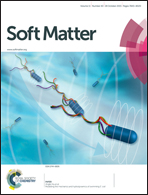Entangled polymer complexes as Higgs phenomena
Abstract
We derive an effective Maxwell–London equation for entangled polymer complexes under topological constraints, borrowing the theoretical framework from topological field theory. We find that the transverse current flux of a test polymer chain, surrounded by entangled chains, decays exponentially from its centerline position with a finite penetration depth, which is analogous to the magnetic-field decay in a superconductor (SC), referred to as the Meissner effect. Just as the mass acquirement of photons in a SC is the origin of the magnetic-field decay, the polymer obtains uncrossable intersections along the chain due to the preservation of the linking number, which restricts the deviation of the transverse polymer current in the normal direction. The underlying physics is as follows: less flexible polymers have stronger current–current correlations, giving rise to a heavier effective mass of the gauge fields and resulting in a shorter decay length. Interestingly, this picture is well incorporated within the most successful phenomenological theory of the, so called, tube model, the microscopic origins of which researchers have long pursued. The correspondence of our equation of motion to the tube model claims that the confining tube potential is a consequence of the topological constraint (linking number). The tube radius is attributed to the decay length. On increasing the effective mass (by strengthening the interaction at an uncrossable intersection or a number of intersections), the tube becomes narrower. Using this argument, the exponential decay of the chain leakage out of the tube is well understood.


 Please wait while we load your content...
Please wait while we load your content...